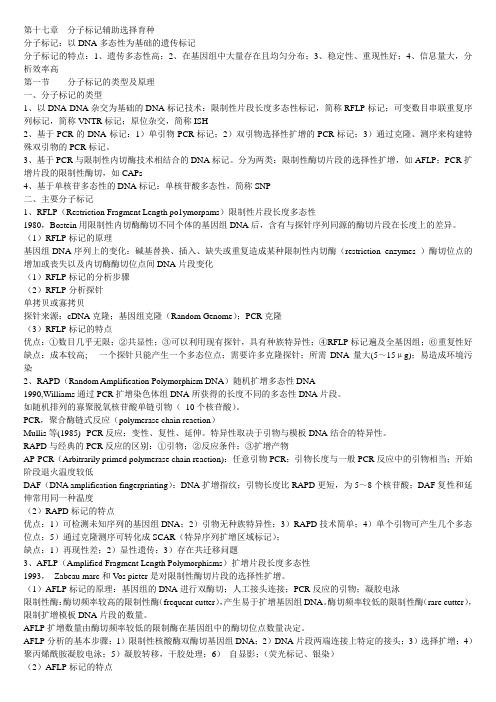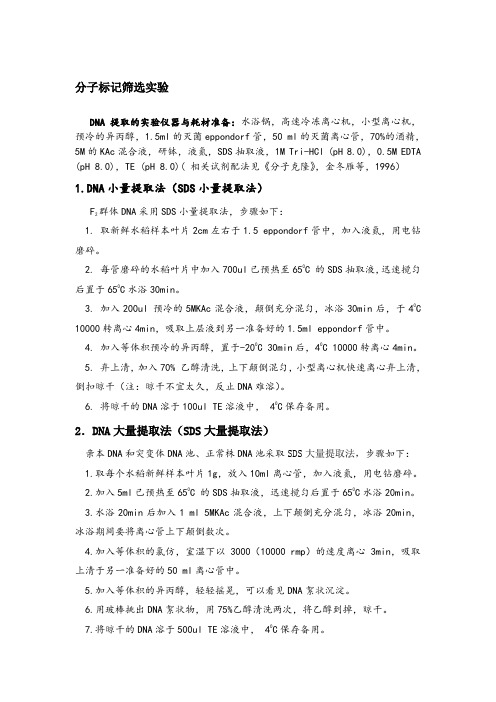第17章 分子标记辅助选择
分子标记辅助选择育种

分子标记辅助选择育种传统的育种主要依赖于植株的表现型选择(Phenotypieal selection)。
环境条件、基因间互作、基因型与环境互作等多种因素会影响表型选择效率。
例如抗病性的鉴定就受发病的条件、植株生理状况、评价标准等影响;品质、产量等数量性状的选择、鉴定工作更困难。
一个优良品种的培育往往需花费7~8年甚至十几年时间。
如何提高选择效率,是育种工作的关键。
育种家在长期的育种实践中不断探索运用遗传标记来提高育种的选择效率与育种预见性。
遗传标记包括形态学标记、细胞学标记、生化标记与分子标记。
棉花的芽黄、番茄的叶型、抗TMV的矮黄标记、水稻的紫色叶鞘等形态性状标记,在育种工作中曾得到一定的应用。
以非整倍体、缺失、倒位、易位等染色体数目、结构变异为基础的细胞学标记,在小麦等作物的基因定位、连锁图谱构建、染色体工程以及外缘基因鉴定中起到重要的作用,但许多作物难以获得这类标记。
生化标记主要是利用基因的表达产物如同工酶与贮藏蛋白,在一定程度上反映基因型差异。
它们在小麦、玉米等作物遗传育种中得到应用。
但是它们多态性低,且受植株发育阶段与环境条件及温度、电泳条件等影响,难以满足遗传育种工作需要。
以DNA多态性为基础的分子标记,目前已在作物遗传图谱构建、重要农艺性状基因的标记定位、种质资源的遗传多样性分析与品种指纹图谱及纯度鉴定等方面得到广泛应用,尤其是分子标记辅助选择(molecular marker-as—sisted selection,MAS)育种更受到人们的重视。
第一节分子标记的类型和作用原理一、分子标记的类型和特点按技术特性,分子标记可分为三大类。
第一类是以分子杂交为基础的DNA标记技术,主要有限制性片段长度多态性标记(Restriction fragment length polymorphisms,RFLP标记);第二类是以聚合酶链式反应(Polymerase chain reaction,PCR反应)为基础的各种DNA指纹技术。
分子标记辅助选择

第十七章分子标记辅助选择育种分子标记:以DNA多态性为基础的遗传标记分子标记的特点:1、遗传多态性高;2、在基因组中大量存在且均匀分布;3、稳定性、重现性好;4、信息量大,分析效率高第一节分子标记的类型及原理一、分子标记的类型1、以DNA-DNA杂交为基础的DNA标记技术:限制性片段长度多态性标记,简称RFLP标记;可变数目串联重复序列标记,简称VNTR标记;原位杂交,简称ISH2、基于PCR的DNA标记:1)单引物PCR标记;2)双引物选择性扩增的PCR标记;3)通过克隆、测序来构建特殊双引物的PCR标记。
3、基于PCR与限制性内切酶技术相结合的DNA标记。
分为两类:限制性酶切片段的选择性扩增,如AFLP;PCR扩增片段的限制性酶切,如CAPs4、基于单核苷多态性的DNA标记:单核苷酸多态性,简称SNP二、主要分子标记1、RFLP(Restriction Fragment Length po1ymorpams)限制性片段长度多态性1980,Bostein用限制性内切酶酶切不同个体的基因组DNA后,含有与探针序列同源的酶切片段在长度上的差异。
(1)RFLP标记的原理基因组DNA序列上的变化:碱基替换、插入、缺失或重复造成某种限制性内切酶(restriction enzymes )酶切位点的增加或丧失以及内切酶酶切位点间DNA片段变化(1)RFLP标记的分析步骤(2)RFLP分析探针单拷贝或寡拷贝探针来源:cDNA克隆;基因组克隆(Random Genome);PCR克隆(3)RFLP标记的特点优点:①数目几乎无限;②共显性;③可以利用现有探针,具有种族特异性;④RFLP标记遍及全基因组;⑥重复性好缺点:成本较高;一个探针只能产生一个多态位点;需要许多克隆探针;所需DNA量大(5~15μg);易造成环境污染2、RAPD(Random Amplification Polymorphism DNA)随机扩增多态性DNA1990,Williams通过PCR扩增染色体组DNA所获得的长度不同的多态性DNA片段。
分子标记辅助选择讲解

第十七章分子标记辅助选择育种传统的育种主要依赖于植株的表现型选择(Phenotypieal selection)。
环境条件、基因间互作、基因型与环境互作等多种因素会影响表型选择效率。
例如抗病性的鉴定就受发病的条件、植株生理状况、评价标准等影响;品质、产量等数量性状的选择、鉴定工作更困难。
一个优良品种的培育往往需花费7~8年甚至十几年时间。
如何提高选择效率,是育种工作的关键。
育种家在长期的育种实践中不断探索运用遗传标记来提高育种的选择效率与育种预见性。
遗传标记包括形态学标记、细胞学标记、生化标记与分子标记。
棉花的芽黄、番茄的叶型、抗TMV的矮黄标记、水稻的紫色叶鞘等形态性状标记,在育种工作中曾得到一定的应用。
以非整倍体、缺失、倒位、易位等染色体数目、结构变异为基础的细胞学标记,在小麦等作物的基因定位、连锁图谱构建、染色体工程以及外缘基因鉴定中起到重要的作用,但许多作物难以获得这类标记。
生化标记主要是利用基因的表达产物如同工酶与贮藏蛋白,在一定程度上反映基因型差异。
它们在小麦、玉米等作物遗传育种中得到应用。
但是它们多态性低,且受植株发育阶段与环境条件及温度、电泳条件等影响,难以满足遗传育种工作需要。
以DNA多态性为基础的分子标记,目前已在作物遗传图谱构建、重要农艺性状基因的标记定位、种质资源的遗传多样性分析与品种指纹图谱及纯度鉴定等方面得到广泛应用,尤其是分子标记辅助选择(molecular marker-as—sisted selection,MAS)育种更受到人们的重视。
第一节分子标记的类型和作用原理一、分子标记的类型和特点按技术特性,分子标记可分为三大类。
第一类是以分子杂交为基础的DNA标记技术,主要有限制性片段长度多态性标记(Restriction fragment length polymorphisms,RFLP标记);第二类是以聚合酶链式反应(Polymerase chain reaction,PCR反应)为基础的各种DNA指纹技术。
分子标记辅助选择课件

以DNA多态性为基础的分子标记,目前已在作 物遗传图谱构建、重要农艺性状基因的标记定位、 种质资源的遗传多样性分析与品种指纹图谱及纯度 鉴定等方面得到广泛应用,尤其是分子标记辅助选 择(molecular marker-assisted selection , MAS )育种更受到人们的重视。
3
– Greatest potential advantage over phenotypic selection for traits with low penetrance or low heritability
May reduce population sizes needed for phenotypic selection
8
Pyramid genes for a single trait that could not otherwise be distinguished at the phenotypic level
– Accumulating multiple quantitative trait loci (QTL) for disease resistance may provide a higher level of resistance and/or more durable resistance to changes in the pathogen population
with a long generation time – Reduce number of generations in a backcrossing program by
selecting for recovery of the recurrent parent genome as well as genes of interest from the donor parent
第17章 分子标记辅助选择

Efficient data tracking, management, and integration with phenotypic data
Decision support tools for breeders
– optimal design of selection strategies – accurate selection of genotypes
Marker technologies provide the potential to understand the underlying causes of epistasis and GXE, which could greatly improve selection efficiency
Paradox of MAS
目的基因与标记连锁(交换值为r)
亲本中的标记带型
mM RS
×
F1中的标记带型 F2群体中3种标记带型
RR (1-r)2 0.9025
RS 2r(1-r) 0.095
SS r2 0.0025
当 r=0.05 时 , 根 据 标 记 基 因 型 mm选择目的基因型RR,选错的 概率约为0.10
Definitions
第17章 MAS-4-辅助选择

三、数量性状的标记辅助选择
质量性状和数量性状的MAS的原理是一样的。原则 上,质量性状的MAS方法也适合数量性状。 作物的大多数性状是数量性状,如产量、生育期等。 因此,对数量性状的MAS极其重要。数量性状的主要遗传 特点就是表现型与基因型之间缺乏明显的对应关系,而传 统方法主要依据个体表现型进行选择的,这是造成传统育 种效率不高的原因。
M1
Gene
M2
抗性供体
M R
受体
m
×
S
目的基因与标记连锁(交换值为r) 亲本中的标记带型
共显 DNA 记的 助选 原理
性 标 辅 择
M R
m S
F1中的标记带型 × F2群体中3种标记带型
RR (1-r)2 0.9025
RS 2r ( 1-r ) 0.09
SS r2 0.0025
当 r=0.05 时 , 根 据 标 记 基 因 型 mm选择目的基因型RR,选错的 概率约为0.10
一 分子标记辅助选择的基本原理
1、概念:目标基因与分子标记紧密连 锁为利用分子标记间接选择提供了方便。 通过基因定位, 找到与目标基因紧密连锁的 分子标记后, 就可以通过该分子标记,间接地 对目标性状进行选择。此法简称分子标记 辅助选择(Molecular Assistant Selection, MAS )。MAS 是育种中的一个诱人领域, 将 给传统的育种研究带来革命性的变化。 MAS 主要应用在有利基因的转移和基因的 累加等方面。 可靠性?? r1 r2
受体亲本 × 供体亲本 (含抗性基因B) (无抗性基因) F1 (含抗性基因B)
标记辅助基 因聚合与品种改 良相结合的技术 路线,受体亲本 应为符合育种目 标的优良品种
复交杂种 (分离群体) 标记辅助选择 中选杂种个体 (含抗性基因A和B)
分子标记辅助选择

• May reduce population sizes needed for phenotypic selection
1) Phenotypic selection (PS)
– based on phenotypic value
2) Marker-based selection (MBS)
– from markers that represent QTL or are linked to QTL
3) Marker-assisted selection (MAS)
2、Most suitable for MAS
• Useful if conventional screening methods are laborious, costly, or environmentally dependent
– Selections for disease and insect resistance can be made in the absence of the pathogen or pest
crops with a long generation time – Reduce number of generations in a backcrossing program
by selecting for recovery of the recurrent parent genome as well as genes of interest from the donor parent
分子标记辅助选择育种

分子标记辅助选择育种传统的育种主要依赖于植株的表现型选择(Phenotypieal selection)。
环境条件、基因间互作、基因型与环境互作等多种因素会影响表型选择效率。
例如抗病性的鉴定就受发病的条件、植株生理状况、评价标准等影响;品质、产量等数量性状的选择、鉴定工作更困难。
一个优良品种的培育往往需花费7~8年甚至十几年时间。
如何提高选择效率,是育种工作的关键。
育种家在长期的育种实践中不断探索运用遗传标记来提高育种的选择效率与育种预见性。
遗传标记包括形态学标记、细胞学标记、生化标记与分子标记。
棉花的芽黄、番茄的叶型、抗TMV的矮黄标记、水稻的紫色叶鞘等形态性状标记,在育种工作中曾得到一定的应用。
以非整倍体、缺失、倒位、易位等染色体数目、结构变异为基础的细胞学标记,在小麦等作物的基因定位、连锁图谱构建、染色体工程以及外缘基因鉴定中起到重要的作用,但许多作物难以获得这类标记。
生化标记主要是利用基因的表达产物如同工酶与贮藏蛋白,在一定程度上反映基因型差异。
它们在小麦、玉米等作物遗传育种中得到应用。
但是它们多态性低,且受植株发育阶段与环境条件及温度、电泳条件等影响,难以满足遗传育种工作需要。
以DNA多态性为基础的分子标记,目前已在作物遗传图谱构建、重要农艺性状基因的标记定位、种质资源的遗传多样性分析与品种指纹图谱及纯度鉴定等方面得到广泛应用,尤其是分子标记辅助选择(molecular marker-as—sisted selection,MAS)育种更受到人们的重视。
第一节分子标记的类型和作用原理一、分子标记的类型和特点按技术特性,分子标记可分为三大类。
第一类是以分子杂交为基础的DNA标记技术,主要有限制性片段长度多态性标记(Restriction fragment length polymorphisms,RFLP标记);第二类是以聚合酶链式反应(Polymerase chain reaction,PCR反应)为基础的各种DNA指纹技术。
分子标记辅助选择

第十七章分子标记辅助选择育种分子标记:以DNA多态性为基础的遗传标记分子标记的特点:1、遗传多态性高;2、在基因组中大量存在且均匀分布;3、稳定性、重现性好;4、信息量大,分析效率高第一节分子标记的类型及原理一、分子标记的类型1、以DNA-DNA杂交为基础的DNA标记技术:限制性片段长度多态性标记,简称RFLP标记;可变数目串联重复序列标记,简称VNTR标记;原位杂交,简称ISH2、基于PCR的DNA标记:1)单引物PCR标记;2)双引物选择性扩增的PCR标记;3)通过克隆、测序来构建特殊双引物的PCR标记。
3、基于PCR与限制性内切酶技术相结合的DNA标记。
分为两类:限制性酶切片段的选择性扩增,如AFLP;PCR扩增片段的限制性酶切,如CAPs4、基于单核苷多态性的DNA标记:单核苷酸多态性,简称SNP二、主要分子标记1、RFLP(Restriction Fragment Length po1ymorpams)限制性片段长度多态性1980,Bostein用限制性内切酶酶切不同个体的基因组DNA后,含有与探针序列同源的酶切片段在长度上的差异。
(1)RFLP标记的原理基因组DNA序列上的变化:碱基替换、插入、缺失或重复造成某种限制性内切酶(restriction enzymes )酶切位点的增加或丧失以及内切酶酶切位点间DNA片段变化(1)RFLP标记的分析步骤(2)RFLP分析探针单拷贝或寡拷贝探针来源:cDNA克隆;基因组克隆(Random Genome);PCR克隆(3)RFLP标记的特点优点:①数目几乎无限;②共显性;③可以利用现有探针,具有种族特异性;④RFLP标记遍及全基因组;⑥重复性好缺点:成本较高;一个探针只能产生一个多态位点;需要许多克隆探针;所需DNA量大(5~15μg);易造成环境污染2、RAPD(Random Amplification Polymorphism DNA)随机扩增多态性DNA1990,Williams通过PCR扩增染色体组DNA所获得的长度不同的多态性DNA片段。
《分子标记辅助选择》幻灯片

分子标记具有明显的优越性:
直接以DNA的形式表现,在各个组织、各发育 时期均可检测,不受季节、环境限制,不存在 是否表达的问题;
数量多,普及整个基因组,检测位点近乎无限;
多态性高,自然存在着许多等位变异,不需要 专门创造特殊的遗传材料;
表现为中性,即不影响目标形状的表达,与不 良性状无必然的连锁;
☆共显性,能够准确判别所有可能的基因型。
• 传统的标记有: • 1、形态学标记:主要指ห้องสมุดไป่ตู้些具有鲜明外
部特征的质量性状,并可以通过表型来推断 其基因型,如毛色、有无犄角等; • 2、细胞学标记:是指染色体形态、数目 和构造的变异,用具有异常染色体的个体与 具有正常染色体的个体杂交或用染色体替换 等手段,可对一些基因进展定位; • 3、生化标记:是在血液或乳中的蛋白质
CAPs
• 又称PCR-RFLP • 即利用特定引物进展PCR扩增,将PCR产物用限
制性内切酶酶切,检测酶切片段大小差异,观察 其多态性。
RAPD
• randomly amplified polymorphic DNA---随 机扩增多态性DNA
• 是基于PCR技术的分子标记,它是用随机序列组 成的寡核苷酸作为引物,通过专门的PCR反响扩 增所获得的长度不同的多态性DNA片段。
AFLP分析步骤:
选用识别4碱基酶切位点的内切酶MseI和识别6碱基酶 切位点的EcoRI〔按概率计算,前者识别的酶切位点 较后者多〕共酶解总DNA;
参加人工合成的并能与MseI,EcoRI两端点连接的接头 分子,再参加分别与两端特异靶序列〔包括两端接头 序列,酶切位点序列以及在3’端延伸的3个随机碱基〕 互补的引物分子进展PCR扩增。
《分子标记辅助选择》幻 灯片
分子标记辅助选择育种

分子标记辅助选择育种????传统的育种主要依赖于植株的表现型选择(Phenotypieal?selection)。
环境条件、基因间互作、基因型与环境互作等多种因素会影响表型选择效率。
例如抗病性的鉴定就受发病的条件、植株生理状况、评价标准等影响;品质、产量等数量性状的选择、鉴定工作更困难。
一个优良品种的培育往往需花费7~8年甚至十几年时间。
如何提高选择效率,是育种工作的关键。
育种家在长期的育种实践中不断探索运用遗传标记来提高育种的选择效率与育种预见性。
遗传标记包括形态学标记、细胞学标记、生化标记与分子标记。
棉花的芽黄、番茄的叶型、抗TMV的矮黄标记、水稻的紫色叶鞘等形态性状标记,在育种工作中曾得到一定的应用。
以非整倍体、缺失、倒位、易位等染色体数目、结构变异为基础的细胞学标记,在小麦等作物的基因定位、连锁图谱构建、染色体工程以及外缘基因鉴定中起到重要的作用,但许多作物难以获得这类标记。
生化标记主要是利用基因的表达产物如同工酶与贮藏蛋白,在一定程度上反映基因型差异。
它们在小麦、玉米等作物遗传育种中得到应用。
但是它们多态性低,且受植株发育阶段与环境条件及温度、电泳条件等影响,难以满足遗传育种工作需要。
以DNA多态性为基础的分子标记,目前已在作物遗传图谱构建、重要农艺性状基因的标记定位、种质资源的遗传多样性分析与品种指纹图谱及纯度鉴定等方面得到广泛应用,尤其是分子标记辅助选择(molecularmarker-as—sisted?selection,MAS)育种更受到人们的重视。
第一节? 分子标记的类型和作用原理一、分子标记的类型和特点????按技术特性,分子标记可分为三大类。
第一类是以分子杂交为基础的DNA标记技术,主要有限制性片段长度多态性标记(Restriction fragmentlength?polymorphisms,RFLP标记);第二类是以聚合酶链式反应(Polymerase?chain reaction,PCR反应)为基础的各种DNA指纹技术。
分子标记辅助选择育种-use

PSM16 PSM30 (AC134231) PSM29 (AC135257) RM338 (AC136284) PSM17 PSM19 (AC107619) PSM55 PSM56 (AC107619) PSM21 PSM47 (AC082644) PSM50 PSM51 (AC087220) PSM48 (AC084765) PSM377 (AC103551) PSM378 (AC079853) PSM379 (AC118134)
Minghui 63 (Xa21)
Markeraided transfer of Xa21 (Chen Sheng and Zhang Qifa)
MH63(Xa21)
MH63(CK)
基因转移实例2
华小黑1号的培育
用高产品种华粳籼74为受体,黑米品种联鉴33为供体, 通过杂交、回交和分子标记辅助选择相结合的方法,将联 鉴33的黑米基因所在的染色体片段转移到华粳籼74中去, 培育出高产的水稻黑米新品种——华小黑1号。
5
6
1.5 3.0 4.6 6.5 12.0
14.1
16.0 17.9 19.6 21.7 23.6 24.7 25.0 29.1 31.1 36.4 37.2 41.4 43.5 48.5 49.4 52.7 54.3
60.7 62.7
66.1 69.0 72.2 74.5 76.2 77.4 80.7 83.2 86.0
4
3.1 5.4 7.9
12.2
17.5 18.3 20.9 23.3
27.0
30.8
36.2
41.5 42.8 46.2 49.7 51.2
分子标记辅助选择实验方法

分子标记筛选实验DNA提取的实验仪器与耗材准备:水浴锅,高速冷冻离心机,小型离心机,预冷的异丙醇,1.5ml的灭菌eppondorf管,50 ml的灭菌离心管,70%的酒精,5M的KAc混合液,研钵,液氮,SDS抽取液,1M Tri-HCl (pH 8.0),0.5M EDTA (pH 8.0),TE (pH 8.0)( 相关试剂配法见《分子克隆》,金冬雁等,1996)1.DNA小量提取法(SDS小量提取法)F2群体DNA采用SDS小量提取法,步骤如下:1. 取新鲜水稻样本叶片2cm左右于1.5 eppondorf管中,加入液氮,用电钻磨碎。
2. 每管磨碎的水稻叶片中加入700ul已预热至650C 的SDS抽取液,迅速搅匀后置于650C水浴30min。
3. 加入200ul 预冷的5MKAc混合液,颠倒充分混匀,冰浴30min后,于40C 10000转离心4min,吸取上层液到另一准备好的1.5ml eppondorf管中。
4. 加入等体积预冷的异丙醇,置于-200C 30min后,40C 10000转离心4min。
5. 弃上清,加入70% 乙醇清洗,上下颠倒混匀,小型离心机快速离心弃上清,倒扣晾干(注:晾干不宜太久,反止DNA难溶)。
6. 将晾干的DNA溶于100ul TE溶液中, 40C保存备用。
2.DNA大量提取法(SDS大量提取法)亲本DNA和突变体DNA池、正常株DNA池采取SDS大量提取法,步骤如下:1.取每个水稻新鲜样本叶片1g,放入10ml离心管,加入液氮,用电钻磨碎。
2.加入5ml已预热至650C 的SDS抽取液,迅速搅匀后置于650C水浴20min。
3.水浴20min后加入1 ml 5MKAc混合液,上下颠倒充分混匀,冰浴20min,冰浴期间要将离心管上下颠倒数次。
4.加入等体积的氯仿,室温下以3000(10000 rmp)的速度离心 3min,吸取上清于另一准备好的50 ml离心管中。
- 1、下载文档前请自行甄别文档内容的完整性,平台不提供额外的编辑、内容补充、找答案等附加服务。
- 2、"仅部分预览"的文档,不可在线预览部分如存在完整性等问题,可反馈申请退款(可完整预览的文档不适用该条件!)。
- 3、如文档侵犯您的权益,请联系客服反馈,我们会尽快为您处理(人工客服工作时间:9:00-18:30)。
May reduce population sizes needed for phenotypic selection
Tester M & Langridge Breeding technologies to increase crop production in a changing world. Science,2010,V 327:818-822
共显性 DNA 标 记的辅 助选择 原理
抗性供体
m
×
R
受体
M S
GWS)
– Select for breeding values summed across many markers without estimation of QTL
(1) selection without test crossing or a progeny test; (2) selection independent of environments; (3) selection without laborious fieldwork or intensive laboratory work; (4) selection at an earlier breeding stage; (5) selection for multiple genes and/or multiple traits; (6) whole genome selection.
第十七章 分子标记辅助选择
第一节 分子标记辅助选择的基本原理 第二节 质量性状的标记辅助选择 第三节 数量性状的标记辅助选择 第四节 分子标记辅助选择的挑战与发展策略
传统的育种主要是根据植株的表现型进行选 择,而环境条件、基因间互作、基因型与环境互作 等多种因素都会影响表型选择效率。
育种者在长期的实践中不断探索运用遗传标记 来提高育种的选择效率与育种预见性。遗传标记包 括形态学标记、细胞学标记、生化标记与分子标记 。
2、Most suitable for MAS
Useful if conventional screening methods are laborious, costly, or environmentally dependent
– Selections for disease and insect resistance can be made in the absence of the pathogen or pest
– from a combination of phenotypic value and marker information
4) Marker-assisted backcrossing (MABC) 5) Marker-assisted recurrent selection (MARS) 6) Genomic Selection or Genome-wide Selection (GS or
with a long generation time – Reduce number of generations in a backcrossing program by
selecting for recovery of the recurrent parent genome as well as genes of interest from the donor parent
– May permit selection of individual plants
May speed up the breeding process
– May be effective for early generation testing – Selections at the seedling stage can be a great advantage in crops
目的基因与标记连锁(交换值为r)பைடு நூலகம்
亲本中的标记带型
mM RS
×
F1中的标记带型 F2群体中3种标记带型
RR (1-r)2 0.9025
RS 2r(1-r) 0.095
SS r2 0.0025
当 r=0.05 时 , 根 据 标 记 基 因 型 mm选择目的基因型RR,选错的 概率约为0.10
Definitions
1、概念:
通过基因定位找到与目标基因紧密连锁的分子标记后, 可通过该分子标记间接地对目标性状进行选择。此法称 分子标记辅助选择(Molecular Assistant Selection, MAS )。
MAS 是育种中的一个诱人领域, 将给传统的育种研究 带来革命性的变化。MAS 主要应用在有利基因的转移和 基因的累加等方面。
以DNA多态性为基础的分子标记,目前已在作 物遗传图谱构建、重要农艺性状基因的标记定位、 种质资源的遗传多样性分析与品种指纹图谱及纯度 鉴定等方面得到广泛应用,尤其是分子标记辅助选 择(molecular marker-assisted selection , MAS )育种更受到人们的重视。
第一节 分子标记辅助选择的基本原理
1) Phenotypic selection (PS)
– based on phenotypic value
2) Marker-based selection (MBS)
– from markers that represent QTL or are linked to QTL
3) Marker-assisted selection (MAS)
Pyramid genes for a single trait that could not otherwise be distinguished at the phenotypic level
– Accumulating multiple quantitative trait loci (QTL) for disease resistance may provide a higher level of resistance and/or more durable resistance to changes in the pathogen population
